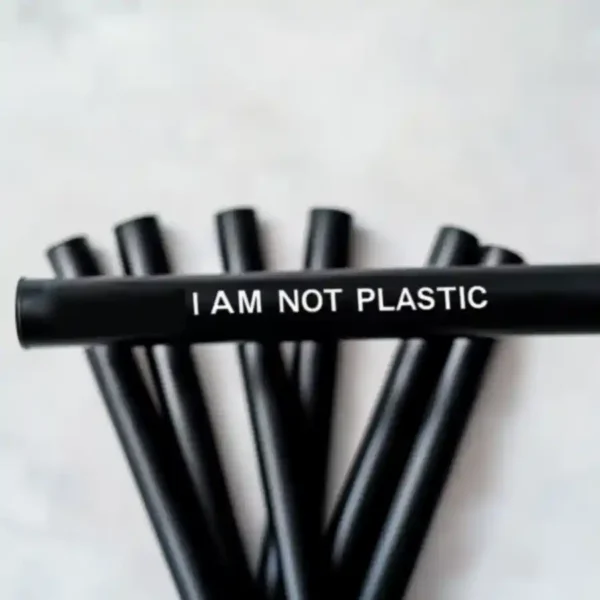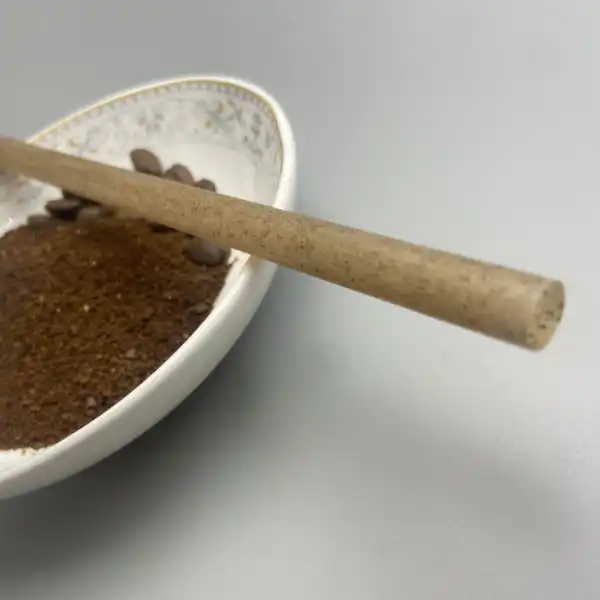
Perkenalan
The pervasive issue of plastic pollution has reached a critical juncture, with an estimated 8 million tons of plastic entering our oceans annually. A seemingly innocuous contributor to this environmental crisis is the single-use plastic straw. These ubiquitous items, often used for mere minutes, persist in the environment for centuries, posing a significant threat to marine life, ecosystems, and ultimately, human health. This article serves as a comprehensive guide to understanding and implementing sustainable straw alternatives, exploring their benefits, challenges, and practical applications for both individuals and businesses. The aim is to provide a detailed overview of viable options beyond traditional plastics.
The Problem with Plastic Straws
The detrimental impact of plastic straws on the environment is multifaceted. A substantial amount of plastic waste, including straws, contaminates our oceans and waterways. Marine animals frequently ingest plastic debris, leading to physical harm, starvation, and entanglement. Furthermore, plastic straws break down into microplastics, which are not only ingested by marine life but also permeate into the soil, air, and water, potentially introducing harmful chemicals into the environment. The slow decomposition rate of plastic means that these pollutants persist for extended periods, exacerbating environmental degradation. Additionally, it has been noted that plastic items, such as straws, can leach harmful toxins into liquids.
Understanding Sustainable Straw Alternatives
The growing awareness of plastic pollution has fueled the development of sustainable alternatives, which can be broadly categorized as follows:
- Biodegradable Straws: These straws are designed to break down naturally through biological processes. The timeline and specific conditions required for biodegradation can vary significantly.
- Compostable Straws: Compostable straws not only biodegrade but also break down into nutrient-rich soil within a specified timeframe under specific composting conditions.
- Home vs. Industrial Compostable: Home-compostable straws can break down in typical backyard compost bins, while industrial-compostable straws require specific conditions found in industrial composting facilities. It is imperative to understand the distinctions in compostability and to look for certifications on product labels, such as from the Biodegradable Products Institute (BPI) in the US or TÜV AUSTRIA in Europe.
- Marine-Degradable Straws: These are designed to break down in marine environments, addressing oceanic pollution and minimizing harm to wildlife.
- Reusable Straws: Reusable straws offer a sustainable alternative to single-use products and are available in a variety of materials such as stainless steel, glass, silicone, and bamboo, providing durable, cost-effective, and portable options. Explore our range of eco-friendly packaging products designed to support sustainable supply chains.
Types of Sustainable Straw Materials

The materials used to create sustainable straws vary in their environmental impact and functional properties.
- Sedotan kertas: Paper straws are often chosen as an alternative to plastic, but it is important to note the manufacturing processes can have an impact on the environment, including the use of chemicals, the processing of paper, and energy usage. Paper straws can also degrade during use and introduce paper debris and harmful chemicals into the surrounding environment.
- Sedotan bambu: Bamboo is a fast-growing and sustainable resource, making bamboo straws an environmentally sound choice. They are durable and reusable, though it is essential to ensure that bamboo is ethically sourced using sustainable farming practices. Check out our customizable bamboo straws for an eco-friendly option.
- Plant-Based Straws: These straws are created from plant-based polymers derived from renewable resources such as corn, sugarcane, and canola. They offer a viable alternative, being both durable and flexible with the capacity to biodegrade. Many plant-based straws are also certified compostable.
- Stainless Steel Straws: Stainless steel straws are particularly suitable for cold beverages and offer a pure taste experience. They are durable and easily cleaned, though the metal can become hot to the touch with hot drinks.
- Glass Straws: Glass straws offer an upscale aesthetic for certain establishments and are reusable. They can also spark conversations among patrons about sustainability.
- Silicone Straws: Silicone straws are known for their flexibility and reusability. However, they can sometimes absorb the flavors of hot drinks, necessitating thorough cleaning between uses.
The Benefits of Switching to Sustainable Straws

Adopting sustainable straw alternatives yields numerous benefits:
- Environmental Benefits: These alternatives significantly reduce plastic waste and pollution, protect marine life, lower carbon footprints, and support a circular economy.
- Health Advantages: Sustainable straws offer safer options than plastic by avoiding the leaching of harmful chemicals and toxins into beverages.
- Brand Enhancement: Businesses that adopt sustainable practices improve their brand image, cultivate customer loyalty, attract eco-conscious consumers, and gain a competitive edge.
- Economic Benefits: In the long term, sustainable straws can lead to savings in waste management costs. Furthermore, businesses might be eligible for government incentives or grants.
- Regulatory Compliance: Switching to sustainable straws ensures compliance with local bans on single-use plastics and avoids potential fines.
Challenges and How to Overcome Them
While the benefits of sustainable straws are clear, there are challenges to consider:
- Cost Barriers: Despite the perception of higher costs, purchasing in bulk and considering long-term savings can mitigate initial expenses.
- Consumer Misconceptions: Addressing concerns about hygiene and usability by providing clear information on cleaning and maintenance, and sharing customer testimonials, can help build trust.
- Supply Chain Issues: Building relationships with reliable suppliers, diversifying sourcing locations, and monitoring inventory closely can help maintain a steady supply.
- Product Quality: Ensuring product quality requires ethical sourcing, sustainability certifications, strict quality checks, and a willingness to adapt based on feedback.
- Waste Management Infrastructure: A lack of access to industrial composting facilities can be a challenge, but businesses can set up on-site compost systems or collaborate with local composting facilities.

Implementing Sustainable Straws in Your Business
A strategic approach is essential for successfully integrating sustainable straws into business operations.
- Assessing Your Needs: Evaluate your current straw usage, identify customer preferences, and consider your brand image and sustainability goals.
- Choosing the Right Suppliers: Source in bulk, check sustainability certifications, build relationships for consistent quality and supply, and prioritize suppliers with transparent supply chains.
- Staff Training and Education: Provide training on the benefits of sustainable straws and proper usage, create informative materials, encourage staff engagement, and provide ongoing education.
- Customer Education and Engagement: Use signage, workshops, and social media to inform customers about your commitment to sustainability, highlight the benefits of sustainable straws, encourage customer feedback, and build a community around sustainability.
- Marketing Your Efforts: Develop a strong brand message that emphasizes sustainability, utilize social media and collaborations with influencers, develop eco-friendly packaging and promotional materials, and promote the sustainability of your straw options in your marketing.
- Cost Analysis and Budgeting: Compare the cost of sustainable straws versus plastic over time, plan for the initial investment, monitor savings, and explore funding options.
- Monitoring and Evaluation: Gather feedback from customers and staff, adjust strategies based on this feedback, and measure success through sales data and customer retention.
Innovative Uses Beyond Beverages

Sustainable straws have diverse applications beyond their traditional use:
- Craft Projects: Straws can be repurposed in DIY crafts and for school or community events.
- Decorative Elements: They can be incorporated into centerpieces and event decorations.
- Promotional Items: Straws can be customized with brand logos for giveaways.
- Themed Designs: Seasonal or event-specific designs can attract attention.
- Eco-conscious Events: Bamboo straws can be utilized at weddings, parties, and corporate events to promote sustainability.
The Future of Sustainable Straws
The landscape of sustainable straws is continually evolving:
- Emerging Trends and Innovations: New materials, like algae or mushroom-based polymers, and innovations in straw design, such as flexible ends or built-in cleaning mechanisms, are under development.
- Governmental and Regional Regulations: Governmental policies and incentives support sustainable alternatives, with plastic straw bans being increasingly implemented.
- Potential Market Disruptions: Sustainable products can enhance brand image and cultivate a loyal base of customers, and the shift to sustainable straws presents a market opportunity for businesses.
- Technological Advancements: Advances in technology are improving the efficiency of production processes, making it easier for businesses to adopt sustainable options.
- The Role of Corporate Social Responsibility: Sustainability is increasingly vital for businesses today, and integrating sustainable straws reflects a commitment to a healthier planet.
- Consumer Behavior and Psychology: Understanding how consumers perceive different types of straws, and why people adopt reusables, can enable businesses to promote sustainable options more effectively.
Case Studies of Success

Numerous businesses have successfully adopted sustainable straws.
- Cafes and Restaurants: Many establishments are sourcing bamboo straws in bulk and displaying sustainability signage. For example, Straws-Berry discusses how eco-friendly straws impact customer perception and loyalty.
- Bars and Hotels: The adoption of glass or metal straws has been well-received, with hotels earning positive reviews for their sustainability initiatives.
- Corporate Initiatives: Companies have incorporated sustainable straws into wellness programs to align with their sustainability goals. The Ultimate Guide to Eco-Friendly Straws by DiyEcoBox provides insights into corporate strategies for integrating sustainable options.
Kesimpulan
The transition from plastic to sustainable straws is not merely an environmental necessity but a strategic opportunity for businesses to enhance their brand image, attract customers, and contribute to a healthier planet. This article has explored the environmental impact of plastic straws, the various sustainable alternatives available, and the practical steps required for their successful implementation. Informed choices about straw selection can make a substantial difference.
Call to Action
It is imperative that businesses and individuals embrace sustainable straw practices. By making conscious choices and taking action, we can contribute to a cleaner, greener world. Share this blog to help spread the word and leave your questions or comments in the section below.
Pertanyaan yang Sering Diajukan (FAQ)
- What are the most effective sustainable straw alternatives?
- Answer: Sustainable straw alternatives include biodegradable straws, compostable straws, marine-degradable straws, and reusable straws made from materials like stainless steel, glass, silicone, and bamboo. Each type has its own benefits and suitability depending on the use case and environmental conditions. For a detailed comparison, visit Understanding Compostable & Sedotan biodegradable.
- How can businesses ensure the quality of sustainable straws?
- Answer: Ensuring the quality of sustainable straws involves ethical sourcing, obtaining sustainability certifications, conducting strict quality checks, and being open to feedback for continuous improvement. Partnering with reputable suppliers and prioritizing transparency in the supply chain also contribute to maintaining high-quality standards.
- What are the main challenges in adopting sustainable straws and how can they be overcome?
- Answer: Main challenges include cost barriers, consumer misconceptions, supply chain issues, product quality, and waste management infrastructure. These can be overcome by purchasing in bulk to reduce costs, educating consumers about the benefits and maintenance of sustainable straws, building strong supplier relationships, ensuring ethical sourcing and strict quality control, and collaborating with local composting facilities or setting up on-site systems.
- Why should I choose bamboo straws over other sustainable options?
- Answer: Bamboo straws are a popular sustainable option because bamboo is a fast-growing and renewable resource. They are durable, reusable, and biodegradable, making them an environmentally friendly choice. Additionally, bamboo straws often come with aesthetic appeal and can be ethically sourced to ensure sustainable farming practices.
- How do sustainable straws contribute to environmental conservation?
- Answer: Sustainable straws reduce plastic waste and pollution, protect marine and terrestrial ecosystems by minimizing harmful impacts, lower carbon footprints through the use of renewable resources, and support a circular economy by promoting the reuse and recycling of materials. By choosing sustainable straws, individuals and businesses can significantly decrease their environmental footprint.







